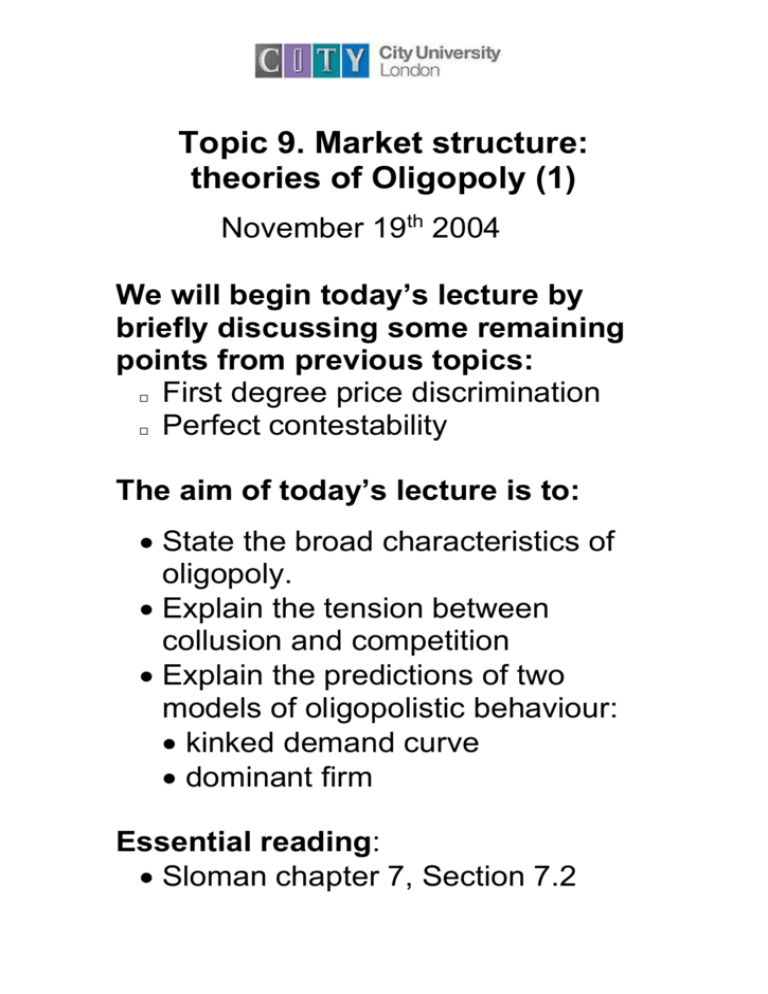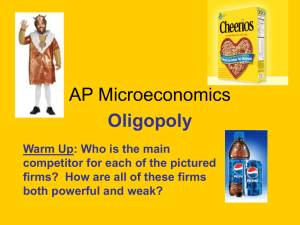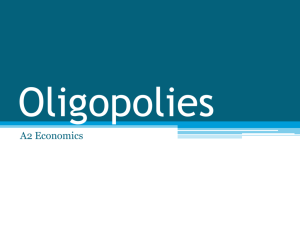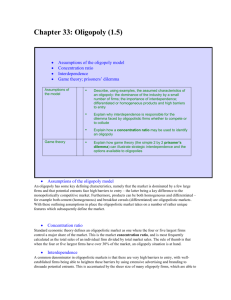Oligopoly (1) kinked demand and price leadership models
advertisement

Topic 9. Market structure: theories of Oligopoly (1) November 19th 2004 We will begin today’s lecture by briefly discussing some remaining points from previous topics: First degree price discrimination Perfect contestability The aim of today’s lecture is to: State the broad characteristics of oligopoly. Explain the tension between collusion and competition Explain the predictions of two models of oligopolistic behaviour: kinked demand curve dominant firm Essential reading: Sloman chapter 7, Section 7.2 1. Oligopoly: assumptions/ characteristics. small number of firms making products that are identical/close substitutes (differentiated) Barriers to entry → firms are not small in relation to the industry as a whole → each firm’s actions affect the industry as a whole → firms cannot take action independently of the expected actions of rival firms Interdependency in decision making is a key feature of oligopoly 2. Firms’ behaviour: compete or collude? Oligopolists are pulled in 2 opposing directions: (a) if they collude with other firms they can jointly act like a monopoly and jointly maximise total industry Π Cartels: price fixing; quotas Tacit collusion But (b) They will be tempted to compete with their rivals to gain a bigger share of industry Π The strategies are incompatible e.g. the more firms compete to get a bigger share of Π, the smaller industry Π become! 3. The breakdown of collusion OLIGOPOLISTIC FIRM (Q=1/5th) OLIGOPOLISTIC INDUSTRY Price Price MC MC Cartel price (=MR if price remains fixed) £10 Cheating MR D D 200 1,000 Quantity 400 600 MR Quantity Cheating How much can we get away with without provoking retaliation? If price war breaks out, will we be the winners? 4. Models There is no single model of oligopoly – but rather a number of models. The specific assumptions underpinning each is different. Dominant firm price leadership under constant shares Kinked demand curve today Game theory under duopoly: optimal strategies under interdependence. Monday 5. Tacit collusion: dominant firm price leadership Assumptions: One large firm in a market, which has cost advantages over other firms, and many small firms, all producing products that are close substitutes. Predictions: The dominant firm behaves as a monopoly and is a ‘price-maker’, since it can ignore the actions of smaller firms. The smaller firms behave as if they are perfectly competitive and are price-takers, given the price set by the dominant firm. 5a. Price leader Π max for a given market share. Price, Cost MC (leader) P MR (leader) Q(leader) Q(industry) D (market) D (leader) Quantity Leader assumes constant market share (why?) Leader chooses Π max Q, where MC = MR, and price = P Other firms ‘take’ that price. Q industry - Q leader = Q followers Limitations: will followers be content with their market share? What if leader’s P (= their MR) > their MC? 6. Kinked demand curve Assumptions: A few firms in a market, each of which believes that if it raises its price other firms will not, but if it cuts its price, so will other firms. Outcome: Discontinuity in the D and MR curves. Prices and quantities are “sticky” with respect to costs; firms do not adjust to small changes in cost Prices may be “sticky” with respect to demand; firms might not adjust prices to small changes in demand, but will change output. 6a: Kinked demand curve & Π max Price, Cost MC P Demand Q MR Quantity Starting at p: If you increase price (and none of your rivals do) big fall in demand High PεD above p Starting at p: If you decrease price (and all your rivals do too) small increase in demand Low PεD below p 6b. Kinked demand curve: unresponsiveness to cost changes Price, Cost MC2 MC1 P D Q MR Quantity MC of producing any given Q has ↑ But Q and P remain unchanged. Suggested to provide a theoretical explanation for the real-world phenomenon of price stability. What if MC ↑ further than MC2? 6c. Kinked demand curve: Responsiveness to demand changes Price, Cost D1 D2 P MC Q1 Q2 MR 1 MR 2 Quantity An exogenous change in demand conditions such that D1 → D2 Π max Q has increased But p remains unchanged Limitation: model does not explain how p determined in the first place. 7. Duopoly Assumptions: Two firms in a market, producing identical products. Identical cost structures. Restrictions on entry to the industry. Next lecture: Modelling decision-making under duopoly using game theory.











